Guest blog post by Sophia de Sousa, Chief Executive of The Glass-House Community Led Design
Last month, I had the immense pleasure of watching my long-time collaborator and now dear friend, Professor Theodore Zamenopoulos, give his Inaugural Lecture as Professor of Citizen-led Design at The Open University. Whilst it was an academic lecture about collaborative design research, it also offered an insightful and inspiring look at the power of design to bring people together, to help us articulate our values, build relationships and alliances, unleash our creativity, to identify shared objectives and to activate change. He clearly illustrated the power of design as a means of responding to opportunities and challenges, but also illustrated that the act of designing collaboratively can itself unleash a whole range of opportunities and impact. As well as joy.
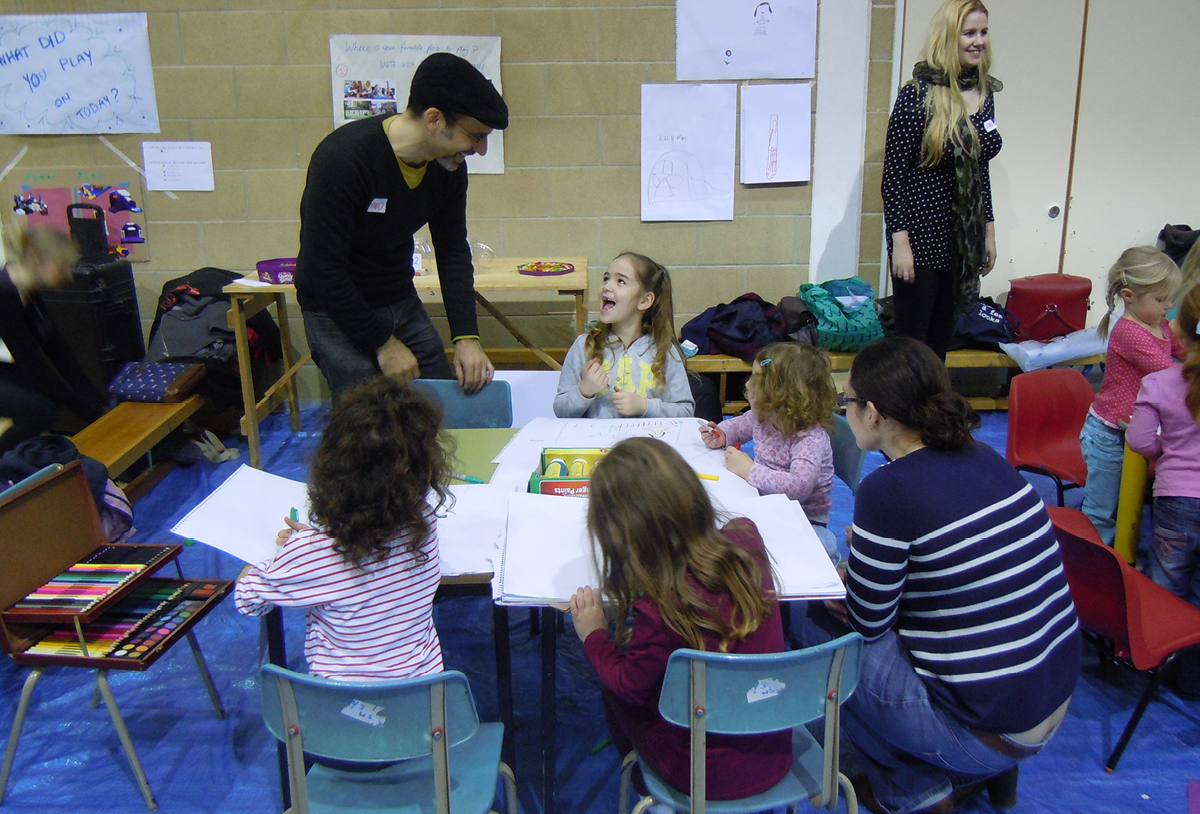
It was an inspiring lecture, which not only represented a significant milestone in his career, but also marked and celebrated the significant milestone of a decade of strategic partnership between The Glass-House Community Led Design and The Design Group at The Open University.
In many ways, ours is an unlikely partnership between an international higher education institution and a small national charity. Indeed, when we decided to formalise our strategic partnership, there was no existing model for us to adopt.
Our partnership had grown out of a meeting I had with Theo and his colleague Dr Katerina Alexiou back in 2010, and our initial collaboration on the project Complexity and the Creative Economy in 2011/12. We three found a synergy in how we wanted to do action research, and shared both values and passions around community leadership and empowerment in and through design and placemaking. Our relationship moved quite quickly into the space of the three of us co-designing and co-producing research, and developing projects that adopted co-design as a principle for collaboration, a way of working together, as well as the focus of our research. We recognised the complementarity of us as individuals, as well as of our organisations and our networks, and thought strategically about how our collaboration with each other, and how connecting our respective networks could enable us to do things we could not do alone.
A New Model for Strategic Partnership
We soon realised that our lines of inquiry, our methods and approaches were evolving across projects, and we started thinking strategically about what we could do in the medium to long term. We were constantly thinking a project or two ahead, and saw each project as a piece of a larger puzzle of what we were, and still are, trying to achieve together. In 2013, we formally committed to a strategic partnership between The Glass-House and The Open University’s Design Group.
There have undoubtedly been challenges along the way linked to bringing together the systems and ways of working of our two organisations that are hugely different in scale, culture and resource and that operate within different sectors. We have had to learn each other’s language, and then work together to shape a new shared language as well as tools and methods.
We have found a way to make it work, and we have benefitted from a hugely rewarding collaboration based on trust, respect and reciprocity.
A Decade of Collaboration, Experimentation and Innovation
Our partnership has also been hugely productive.
Collaboration between The Glass-House and the Design Group now spans 16 funded action research projects and has mobilised £2.6 million in research funding for our work to enable and empower community participation and leadership in design, as well as cross sector collaboration through design. Through both funded research and other joint initiatives, we have collaborated on: over a hundred workshops and events; connecting, supporting and collaborating with over 100 community-based groups and organisations; training both practising and emerging professionals; supporting live student projects that link students with community-led projects; co-designing and co-producing a broad range of practical resources in mixed media for communities and professionals; co-authoring academic papers and even an online course. We have submitted evidence and made practical recommendations to central government, professional membership bodies, and to funders.
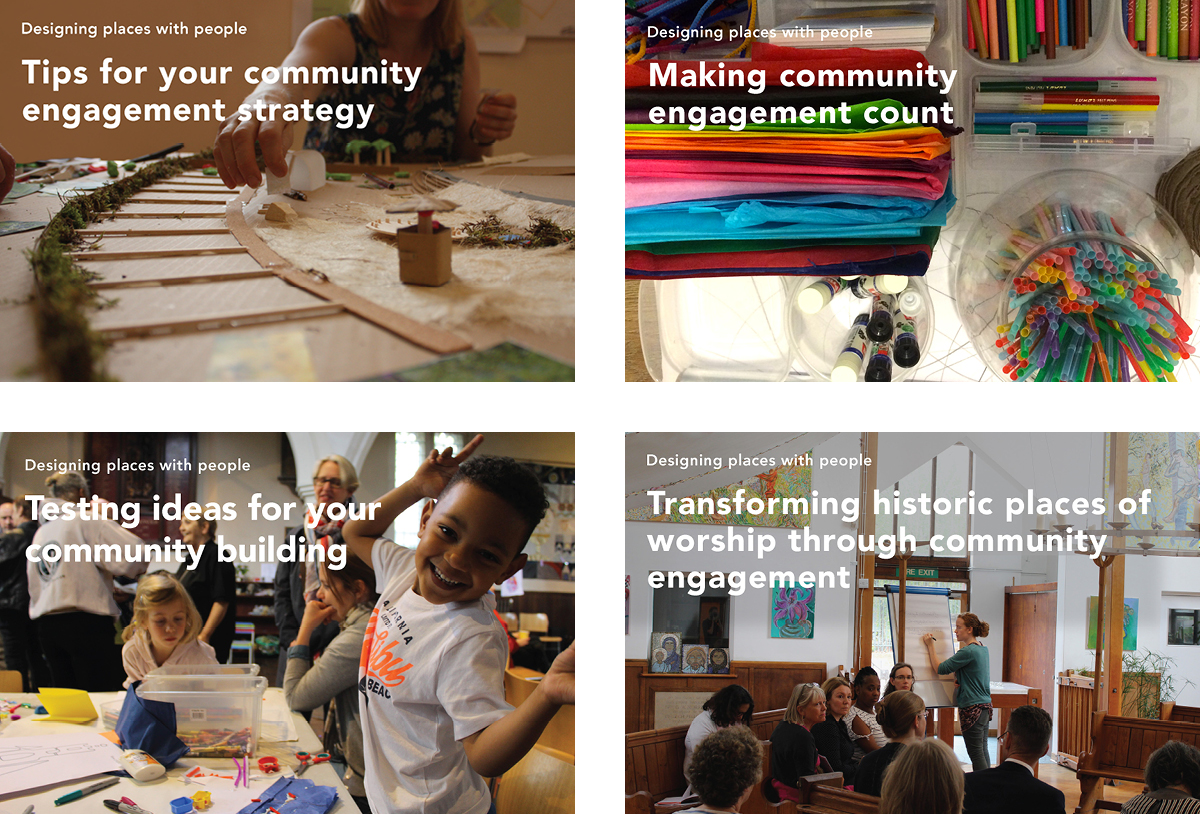
Empowering Design Practices (EDP), our largest collaborative research project to date, saw us working with 55 communities across England and Scotland, delivering 65 workshops and events and connecting with 1250 members of the public through our activities. The project also produced a large range of practical resources (see links below), which emerged through our collaboration with communities and professionals alike. The project was awarded the Open University’s 2022 Research Excellence Award for Outstanding Impact of Research on Society and Prosperity.
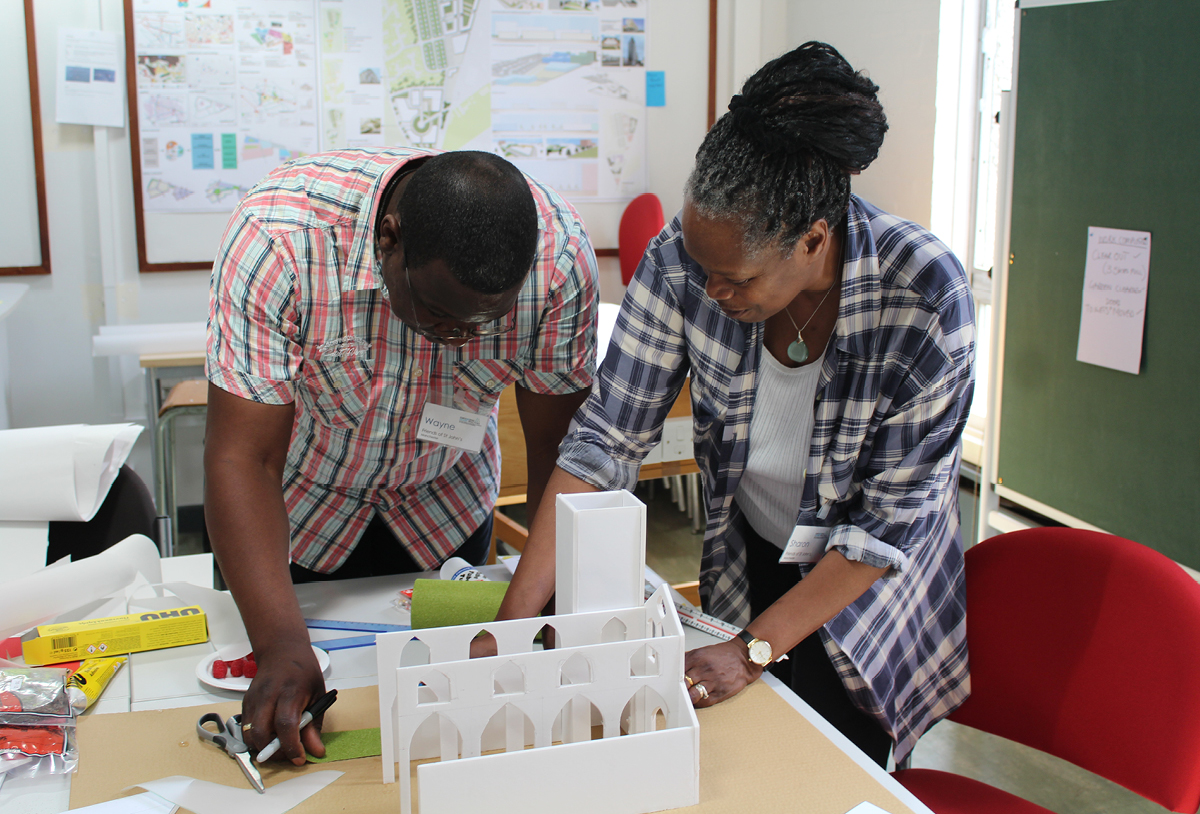
Teaching and capacity building has also been at the heart of our collaboration, and this has proven another intriguing and fruitful space for this partnership. We are interested in how our work can help develop and test educational resources and opportunities for teaching within higher education institutions, and in schools, for continuing professional development for practitioners and to provide capacity building or training for communities. We are also keen to explore how these learning paths can better intersect and create new learning opportunities through their cross-pollination.
One example of this is our work with live projects in built environment degree courses, which see students working with a local community-based group or organisation on their live or emergent design or placemaking project. We have supported students with mentoring, the community groups with design training, and have explored the impact of live projects across a number of universities for tutors, students and the community groups with which they are working.
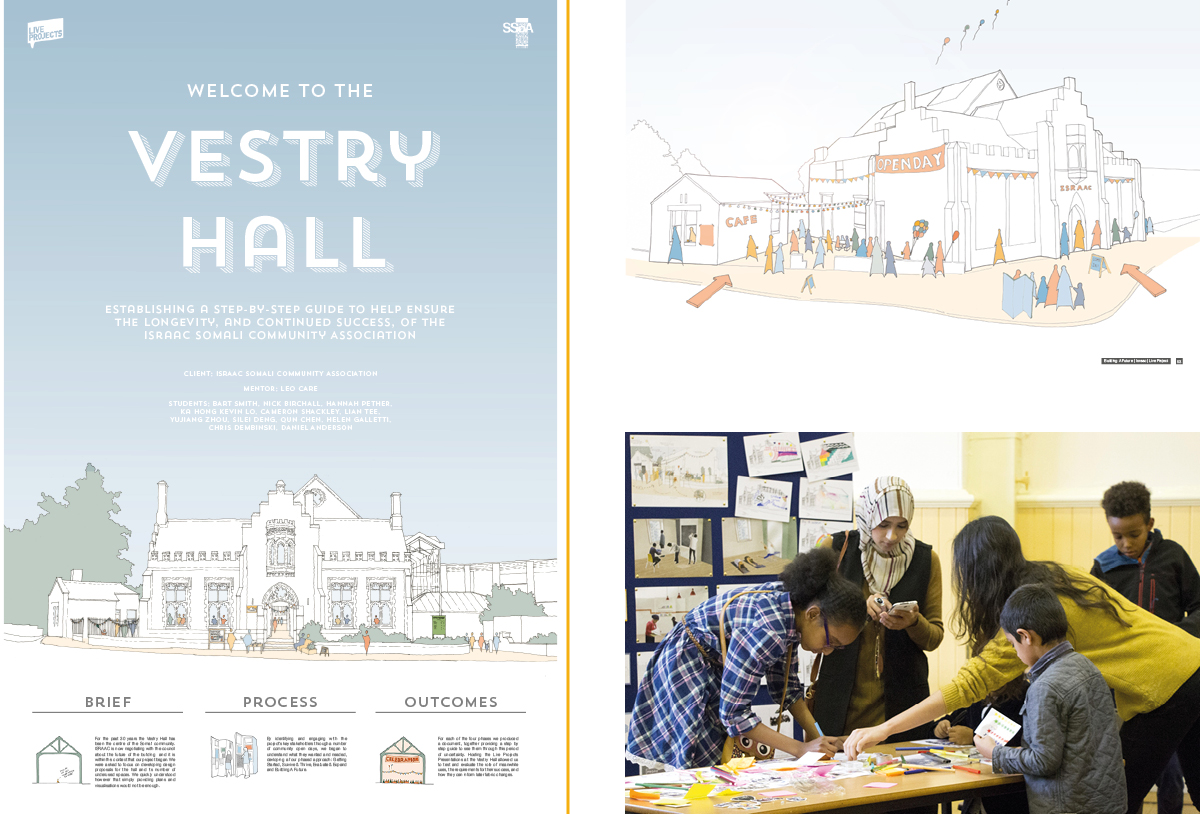
Working with o ur other partners, we have also taken our methods and approaches to other countries, taking asset-mapping and cross-pollination to Greece through the Co-designing asset mapping: comparative approaches project and taking and the Design by Consensus workshop model to China through the Fostering Creative Citizens through Co-design and Public Makerspaces. In our Bridging the Gap project, we worked with partners in the UK and Japan to gather stories of resilience and rebuilding after the 2014 Tsunami in Japan, and brought them back to the UK as Lessons from Minamisanriku, which inspired a workshop with students at Brunel University through the Scaling up Co-design project. We learned about Spaces for Connection in China, and linked Chinese innovators of the Taobao Village with an English local authority seeking new ways to activate local micro businesses.
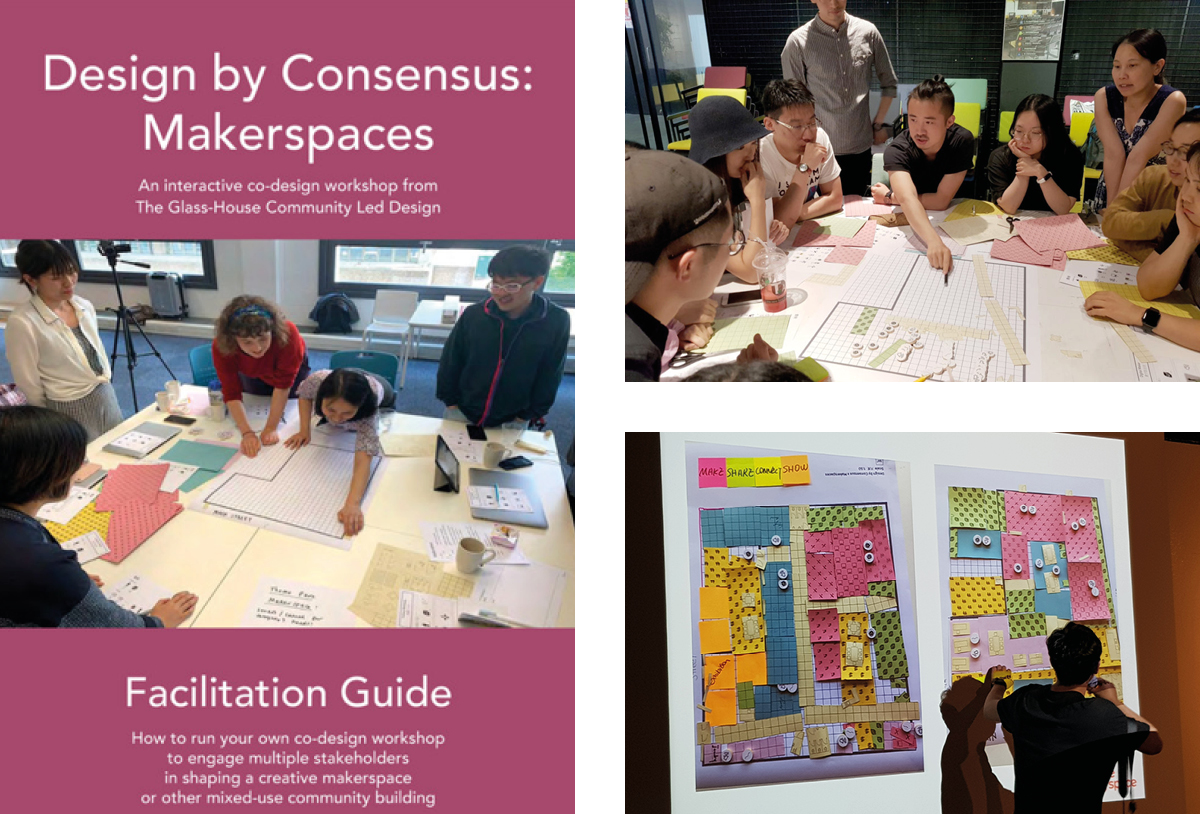
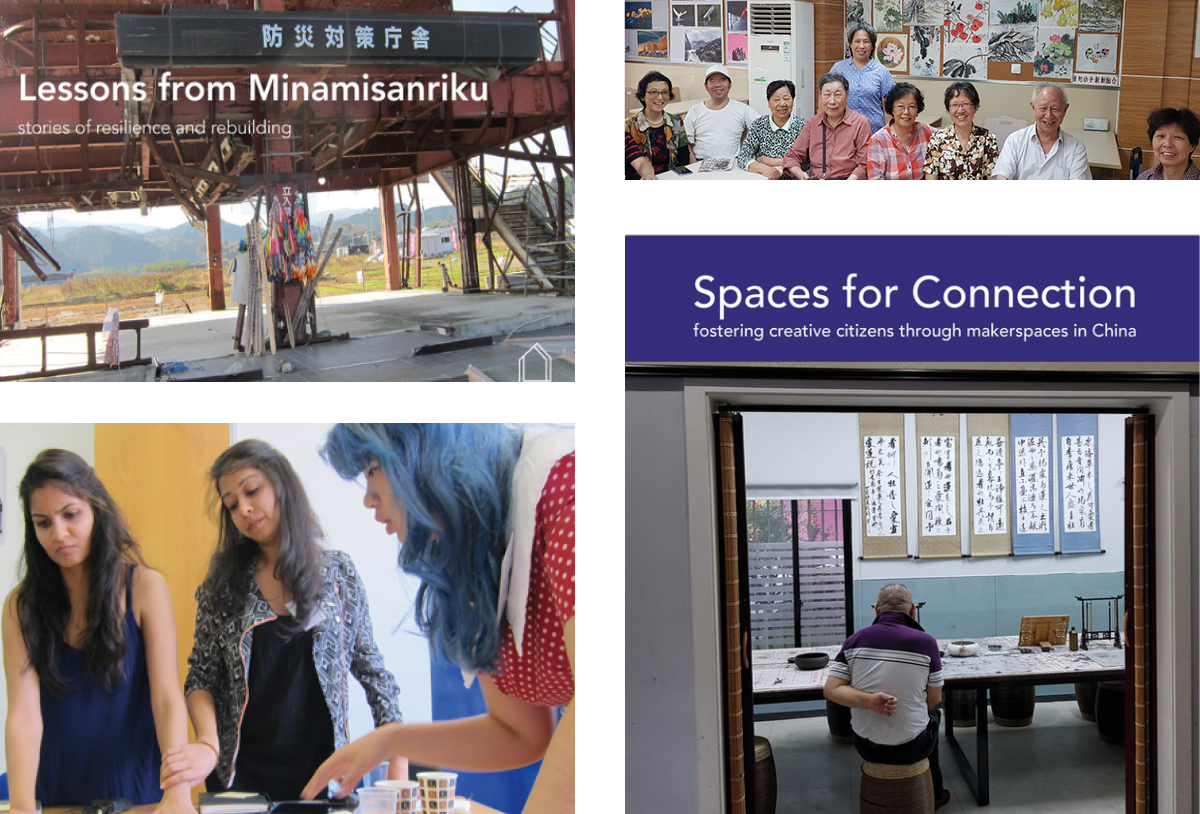
We are constantly trying to translate the learning from our work into educational resources, but also exploring how to equip and empower design champions who can help cascade that learning further. Our most recent knowledge exchange project, Cross-pollination: Growing cross-sector design collaboration in placemaking, has seen us work with organisations and networks in the four nations to empower others to use this creative and hands-on approach (with which we have been experimenting for nearly a decade) to support cross-sector collaboration in their areas.
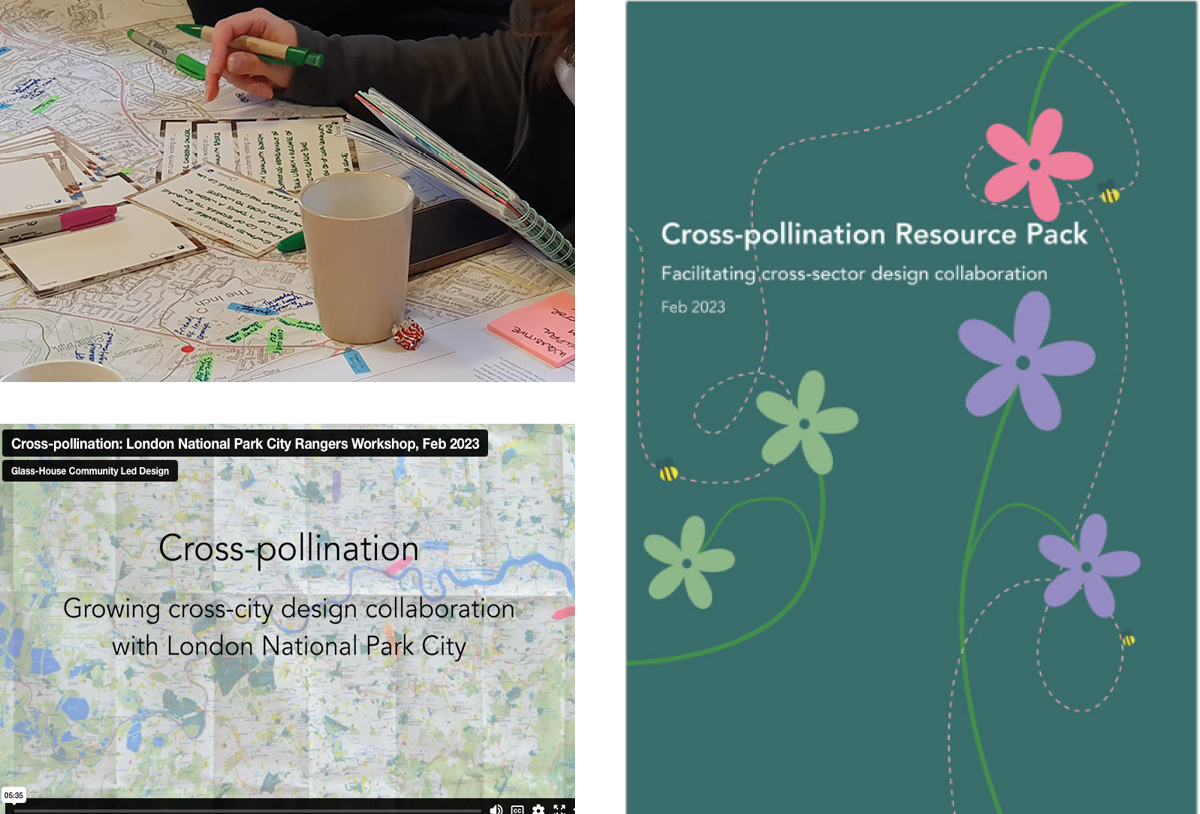
A Truly Collaborative Journey
Most importantly, we have created a strategic partnership built on mutual respect, admiration and support that makes it possible to co-design and co-produce research activities that lead to both academic and practical outcomes and outputs with every project. Each collaborative activity builds on the learning and innovation from the previous ones. We are constantly prototyping, testing, iterating and sharing our methods and approaches. We want to help more people do what we do and help others enjoy collaborative partnerships, design and placemaking as we do.
For me, Theo’s lecture offered a space for my own reflection on the huge volume of work that The Glass-House has done in collaboration with my treasured colleagues and friends at The Open University. I felt an enormous sense of pride, gratitude and affection for my colleagues Theo, and Katerina and also Vera Hale, who first stepped into this group as a Glass-House Enabler and who is now not only a core member of our research team, but also works at The Open University within the Design Group. And there have been many other collaborators from the Open University’s Design Group, including Jeff Johnson, Derek Jones, and Georgy Holden as well as countless others from other faculties and departments. Whilst I have had the pleasure of being The Glass-House strategic lead throughout this past decade, there have been many other members of The Glass-House staff who have contributed enormously to this work, including Rebecca Maguire, Hannah Gibbs, Maja Luna Jorgensen, Louise Dredge, Lucia das Neves, Melissa Lacide, Grace Grannis, Myra Stuart, Elly Mead, Jake Stephenson Bartley and Louise Dennison. Not to mention our interns and volunteers along the way.
Of course, this longstanding research collaboration has involved numerous other partners (and people) in higher education, local government, practice and industry. Above all, we have connected and collaborated with a huge number of people and community-based groups and organisations throughout the UK .
We are talking about the involvement of hundreds of groups and organisations, and of thousands of people.
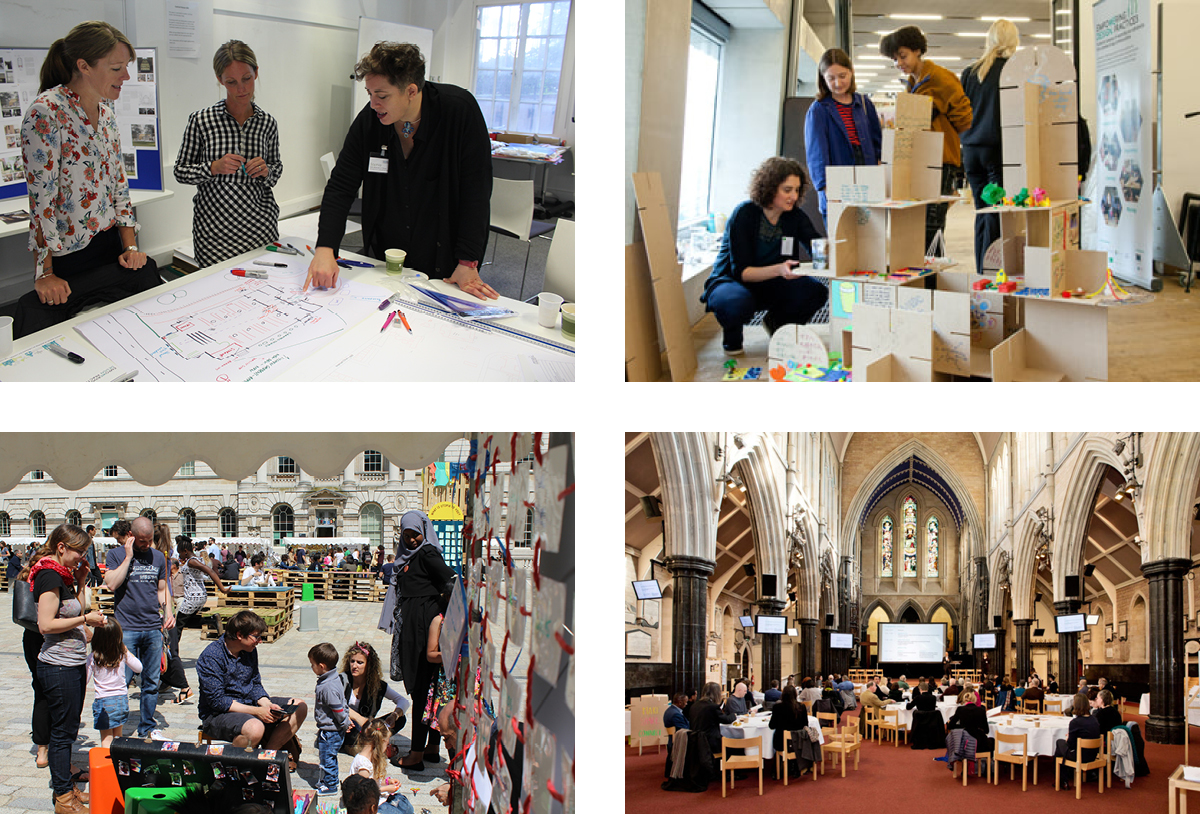
The Value of Creative Tools and Methods
During his lecture, Theo spoke of the value of what he refers to as design creatives, people and organisations from all walks of life and disciplines, who unleash the power of design and empower others to engage with, contribute to and benefit from it. In a way, that’s a simple and powerful way to sum up this decade of collaboration. Our aim is to enable and empower the design creative in everyone, in every community, and in every sector and discipline, with the hope of creating more equitable, sustainable and joyous places, and of unleashing the social value opportunities that we feel, we know and can now prove, that design and collaborative placemaking can offer.
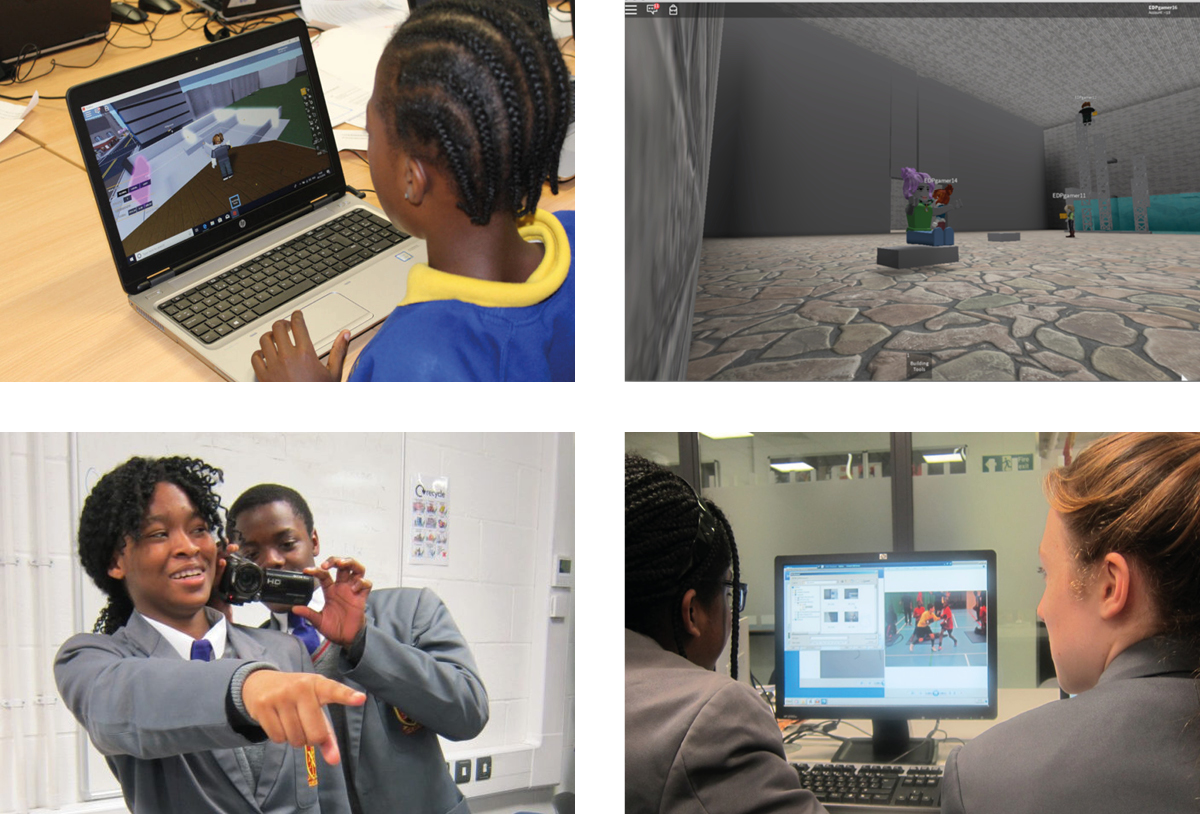
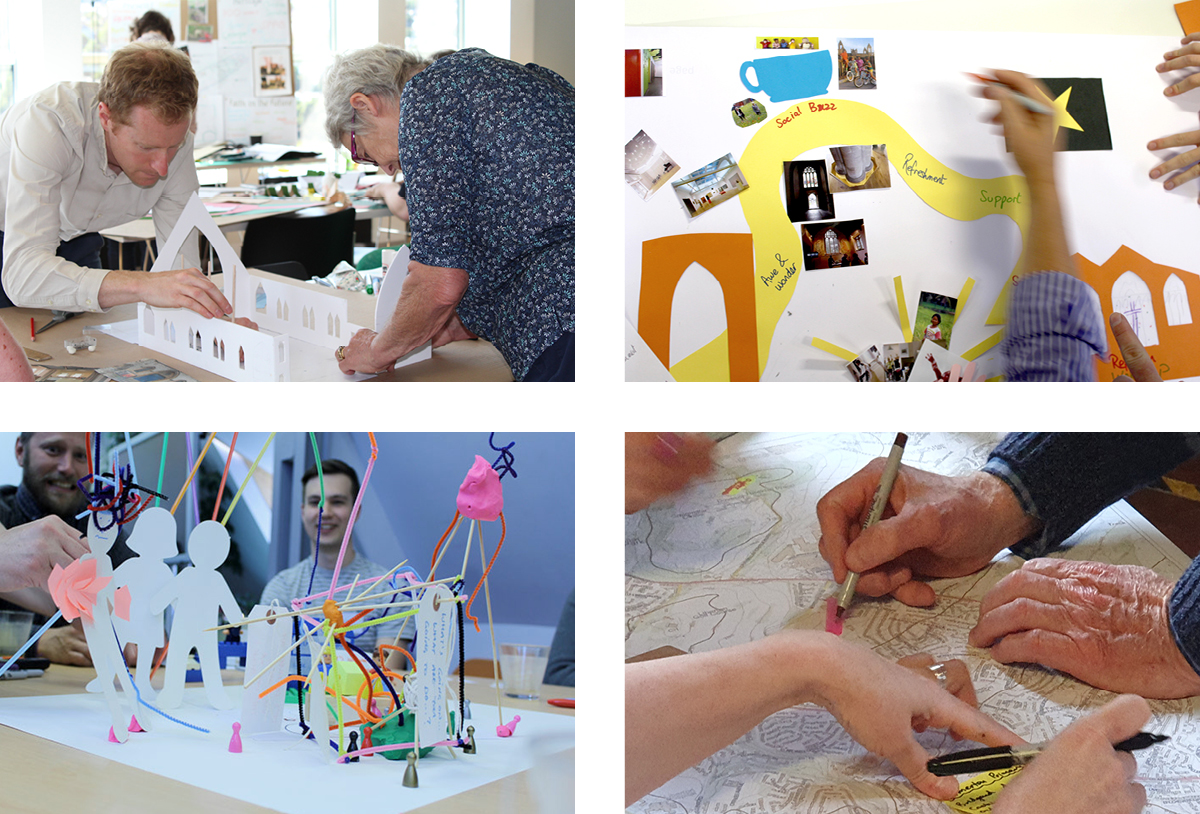
We often talk about the power of planting seeds, and if only a small percentage of those with whom we have connected through our strategic partnership and collaborative research have been supported, inspired or empowered, then they too will one day be able to plant their own seeds and the movement of people working collaboratively to transform their places through collaborative design will grow. We know that many have already started sowing their own seeds.
Looking back on a decade of collaboration between The Glass-House and the Design Group at The Open University, I feel a sense of accomplishment, but also a huge sense of gratitude to the very many people who have contributed to our work, and so generously. Our partnership has felt enormously privileged to be welcomed into so many communities, networks and conversations and we know that whatever we have achieved has been thanks to a huge collaborative effort involving very many others.
And we have not finished yet. We are already developing new projects and planning what to do next. We know we are onto something here, and we will keep experimenting, connecting and collaborating.
Long may this strategic partnership continue and our collaborative network continue to grow.
Further links:
We won’t attempt to list everything we have done together, but here are links to more information on our joint work and to some of the practical resources and academic papers that we have co-produced.
Action research projects
- Cross-pollination: Growing cross-sector design collaboration in placemaking (2022)
- Incubating Civic Leadership (2021/22) in collaboration with Knowle West Media Centre & London Borough of Redbridge
- Mapping Civic Leadership (2021)
- Fostering Creative Citizens through Co-design and Public Makerspaces (2018 – 2021) led by Brunel University with partners Tongji University in Shanghai, China
- Empowering Design Practices (2014-2021) with partners including Historic England, National Lottery Heritage Fund and Historic Religious Building Alliance.
- Prototyping Utopias (2016) with Bow Arts, Poplar Harca, Bow Church, Bromley-by-Bow Centre.
- Cross-pollination Writing Retreat (2016/17) led by Brunel University, with Keele University, University of Leicester, New Vic Theatre.
- Rules of Thumb (2015) led by Brighton University
- Starting from values: evaluating intangible legacies of Connected Communities projects (2014-15): Led by Brighton University, with partners from Scaling up co-design research and practice project and the Authority Research Network.
- Co-designing asset mapping: comparative approaches (2014): with Keele University, Brunel University, Royal College of Art, University of Leicester, New Vic Theatre and Atenistas.
- Scaling up co-design research and practice: building community-academic capacity and extending reach (2013-14): with Brunel University, University of Sheffield, Northumbria University, Blackwood Foundation, Silent Cities, One Westminster and Fossbox.
- Unearth Hidden Assets through Community Co-design and Co-production (2013-14): led by Brunel University, with The Glass-House and The Open University working with Tidworth Mums, Wiltshire District Council.
- Bridging the Gap between Academic Rigour & Community Relevance: Fresh Insights from American Pragmatism (2013-14): Led by Keele University, with partners including Seinan Gakuin Uni Japan, New Vic Theatre and the Mondo Challenge Foundation.
- Media, Community and the Creative Citizen (2012-14): led by Cardiff University, with Royal College of Art, Birmingham City University, University of West England, University of Birmingham, NESTA, OFCOM, Talk About Local, South Blessed, Moseley Exchange and The Glass-House.
- Valuing Community-Led Design (2012-13)
- Complexity and the Creative Economy (2011/12): led by University of Kent, with University of Birmingham
Teaching & Practical Resources
Online course / Interactive websites
- Enabling Community-based Leadership in Design: Sustainable Development of Historic Faith Buildings (2021) – online course
- Explore Design: Community Buildings (2019) – interactive website
- A Design Thinking Guide (2019) – interactive website
Case studies, top tips and facilitation guides
- Cross-pollination:Resource Pack (2023) – publication
- Design by Consensus: Makerspaces facilitation guide (2021) – publication
- Preparing to Work with Architects (2020) – publication
- Digital Media and Community Led Design (2020) – publication
- Using Digital Media (2020) – film
- Spaces for Connection: Fostering Creative Citizens through Makerspaces in China (2020) – publication
- Community-led Transformation of Historic Places of Worship: Some key considerations (2020) – publication
- Stories of Community Engagement in design (2019) – inspirational films
- Designing Places with People: Tips for your Community Engagement Strategy (2019) – publication
- Designing Places with People: Making Community Engagement Count (2019) – publication
- Designing Places with People: Testing Ideas for Your Community Building (2019) – publication
- Designing Places with People: Transforming Historic Places of Worship through Design Engagement (2019) – publication
- Design Project Stories (2018) – online/downloadable case studies
- Developing a Shared Purpose (2016) – film capturing a workshop
- Lessons from Minaminsanriku: Stories of Resilience and Rebuilding (2015 as blog series, 2020 as publication)
- Asset Mapping Approaches (2014) – online case studies
- Tidworth Mums: A Case for Soft Play (2014) – publication
- Creative Citizens Variety Pack (2014) – publication
- Seeing Things Differently Activity Pack (2014) – Publication
Films capturing our work
- Cross-pollination: Growing cross-city design collaboration with London National Park City (2023)
- Cross-Pollination: Growing Cross-sector collaboration in Merthyr Tydfil (2022)
- Incubating Civic Leadership Film & Case Study Films (2021)
- Empowering Design Practices Live (2019)
- Engaging Communities in Design Decision-Making (2019)
- Design Training: Empowering Communities to Unlock Place Potential (2018)
- Beyond Buzzwords: The Language of Collaborative Design (2018)
- Prototyping Utopias (2016)
- Scaling Up Co-Design Research and Practice (2016)
- Valuing Community Led Design (2013)
Co-authored Academic Papers
- Alexiou, K., Zamenopoulos, T., Hale, V, and de Sousa, S. (2022) Incubating civic leadership in design: the role of cross-pollination spaces. In: DRS2022: Bilbao (Lockton, D; Lenzi, S; Hekkert, P; Oak, A; Sabada, J and Lloyd, P eds.), Design Research Society.
- Zamenopoulos, T., Lam, B., Alexiou, K., Kelemen, M., de Sousa, S., Moffat, S. and Phillips, M. (2021). Types, obstacles and sources of empowerment in co-design: the role of shared material objects and processes. CoDesign: International Journal of CoCreation in Design and the Arts, 17(2):139–158
- Alexiou, K., Zamenopoulos, T., Hale, V., West, S. and de Sousa, S., (2020) Empowering Design Practices: exploring relations between architecture, faith, society and community in Open Arts Journal(9), article no. 5
- Lam, Busayawan; Phillips, Martin; Kelemen, Mihaela; Zamenopoulos, Theodore; Moffat, Susan and de Sousa, Sophia (2018). Design and Creative Methods as a Practice of Liminality in Community-Academic Research Projects. The Design Journal, 21(4) pp. 605–624
- Brigstocke, J., Hoover, E., Harder, M., Graham, P., de Sousa, S., Dearden, A., Light, A., Zamenopoulos, T., Alexiou, K., Burford, G., Gaubert, J., Foskett, C., (2017) ‘Implicit Values: Uncounted Legacies’, In Valuing Interdisciplinary Collaborative Research: Beyond Impact, Facer and K. Pahl editors, Policy Press, pp 65-83. ISBN 978-1-4473-3162-9
- Alexiou, K., Alevizou, G., de Sousa, S., Dredge, L. and Zamenopoulos, T. (2015) Learning from the use of media in community-led design projects, Journal of Cultural Science, 8(1): 30-40

Leave a Reply